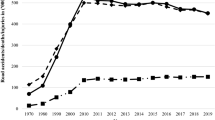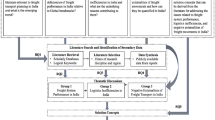Abstract
This paper considers problems of analyzing and forecasting the system of interregional economic interactions. The possibilities of creating an interregional balance of manufacturing and consumption of products using data on freight traffic on the railway network are shown. The calculations of the economic connectivity of individual macroregions of the country are provided.


Similar content being viewed by others
Notes
The position of Rosstat on this issue is described in sufficient detail in article [10].
For a number of years, the INP RAS has been collaborating with the Institute of Economics and Transport Development (IERT) in generating forecasts for freight rail transportation. The basis of the forecast is the statistics of JSC Russian Railways [13].
The structure of the real sector includes the following economic activities: agriculture and forestry, mining, manufacturing, production and distribution of electricity, gas, and water, construction, and transport and communications.
If we consider the actual output and intermediate consumption throughout the economy, then the model can describe the entire set of relations existing in the country. This is exactly how models like those of L. Moses and W. Isard function [15, 16], in which, for example, trade coefficients important for a particular model are calculated on the basis of transportation data.
Coefficients of full and direct costs for the most important relationships at the level of individual regions are given in the Appendix.
REFERENCES
A. G. Aganbegyan, K. A. Bagrinovskii, and A. G. Granberg, The System of Models of National Economic Planning (Mysl’, Moscow, 1972) [in Russian].
A. G. Granberg, Optimization of the Territorial Proportions of the National Economy (Ekonomika, Moscow, 1973) [in Russian].
N. N. Mikheeva, Regional Economics and Management. Textbook for Universities (RIOTIP, Khabarovsk, 2000) [in Russian].
Integrated Spatial Research, Ed. by A. A. Adamesku (Vseross. Akad. Vneshn. Torg. Ministerstva Ekon. Razvit. Ross. Fed., Moscow, 2019) [in Russian].
A. G. Granberg, V. I. Suslov, and S. A. Suspitsyn, Multiregional Systems. Economic and Mathematical Research (Sib. Nauchn. Izd., Novosibirsk, 2007) [in Russian].
V. I. Suslov, N. M. Ibragimov, and L. V. Mel’nikova, “Coalition analysis and effects of interregional integration,” Ekon. Reg. 14 (4), 1131–1144 (2018).
A. A. Adamesku, “Features of the development methodology of the first General layout of the distribution of productive forces,” Regionologiya, No. 2, 66–75 (2008).
M. N. Uzyakov, N. N. Sapova, and A. A. Khersonskii, “A toolkit for macrostructural regional forecasting: Methodological approaches and results of computations,” Stud. Russ. Econ. Dev. 21, 109–123 (2010).
W. Isard, I. J. Azis, M. P. Drennan, R. E. Miller, S. Saltzman, and E. Thorbecke, Methods of Interregional and Regional Analysis (Routledge, 2017).
I. D. Masakova, " The Russian practice of compiling input-output tables: Problems and prospects of development," Stud. Russ. Econ. Dev. 30, 119–128 (2019).
A. R. Sayapova, “Input-output tables in the analysis and forecasting of structural parameters of the region’s economy,” Probl. Prognozirovaniya, No. 6, 28–41 (2004).
Z. B.-D. Dondokov, K. P. Dyrkheev, L. A. Munaev, P. B. Abzaev, and S. V. Rinchino, “Intersectoral analysis of the economy of the Republic of Buryatia on the basis of input-output tables,” Reg. Ekon.: Teor. Prakt., No. 28, 55–62 (2014).
V. V. Ivanter, V. V. Mikhailov, F. S. Pekhterev, M. N. Uzyakov, A. A. Zamkovoi, A. A. Shirov, P. A. Shestakov, E. V. Popova, and M. V. Leshchev, Application of Input–Output Models for Scientific Justification of Strategic Development of the Railway System of Russia (UP PRINT, Moscow, 2015) [in Russian].
A. A. Shirov, M. S. Gusev, A. Yu. Kolpakov, et al., Transformation of the Structure of the Economy: Mechanisms and Management (MAKS Press, Moscow, 2018) [in Russian].
L. N. Moses, “The stability of interregional trading patterns and input-output analysis,” Am. Econ. Rev. 45 (5), 803–832 (1955).
W. Isard, Methods of Regional Analysis: An Introduction To Regional Science (Wiley, New York, 1960).
ACKNOWLEDGMENTS
The author thanks researchers of the IEF RAS N.N. Mikheeva, V.V. Potapenko, N.N. Sapova, A.R. Sayapova, A.V. Suvorov, and A.A. Yantovskii for useful tips and help in writing this article.
Author information
Authors and Affiliations
Corresponding author
Ethics declarations
The authors declare that they have no conflict of interest.
Additional information
Translated by K. Lazarev
APPENDIX
APPENDIX
Assessment of the most important interregional ties in the consumption of intermediate products in 20177
Rank | Manufacturing | Consumption | Total cost factor | Direct cost factor |
|---|---|---|---|---|
1 | Khabarovsk krai | Primorskii krai | 0.224 | 0.198 |
2 | Krasnoyarsk krai | Khabarovsk krai | 0.169 | 0.145 |
3 | Khabarovsk krai | Jewish Autonomous oblast | 0.096 | 0.077 |
4 | Irkutsk oblast | Transbaikal krai | 0.086 | 0.069 |
5 | Kemerovo oblast | Altai krai | 0.073 | 0.060 |
6 | Irkutsk oblast | Primorskii krai | 0.072 | 0.049 |
7 | Kemerovo oblast | Primorskii krai | 0.071 | 0.053 |
8 | Krasnoyarsk krai | Republic of Khakassia | 0.070 | 0.067 |
9 | Altai krai | Lipetsk oblast | 0.066 | 0.064 |
10 | Tyumen oblast | St. Petersburg | 0.062 | 0.062 |
11 | Kemerovo oblast | Novosibirsk oblast | 0.058 | 0.047 |
12 | Vologda oblast | Kostroma oblast | 0.057 | 0.054 |
13 | Chelyabinsk oblast | Volgograd oblast | 0.057 | 0.050 |
14 | Omsk oblast | Novosibirsk oblast | 0.051 | 0.046 |
15 | Belgorod oblast | Lipetsk oblast | 0.050 | 0.048 |
16 | Chelyabinsk oblast | Sverdlovsk oblast | 0.049 | 0.049 |
17 | Leningrad oblast | Novgorod oblast | 0.048 | 0.046 |
18 | Vologda oblast | Ivanovo oblast | 0.047 | 0.045 |
19 | Yaroslavl oblast | Republic of Karelia | 0.047 | 0.043 |
20 | Amur oblast | Khabarovsk krai | 0.047 | 0.040 |
21 | Omsk oblast | Kemerovo oblast | 0.046 | 0.036 |
22 | Kemerovo oblast | Tula oblast | 0.043 | 0.035 |
23 | Chelyabinsk oblast | Ulyanovsk oblast | 0.043 | 0.043 |
24 | Samara oblast | Krasnodar krai | 0.042 | 0.038 |
25 | Yaroslavl oblast | Tver oblast | 0.041 | 0.038 |
26 | Ryazan oblast | Smolensk oblast | 0.040 | 0.037 |
27 | Belgorod oblast | Tula oblast | 0.040 | 0.039 |
28 | Chelyabinsk oblast | Republic of Bashkortostan | 0.040 | 0.035 |
29 | Yaroslavl oblast | Pskov oblast | 0.039 | 0.034 |
30 | Lipetsk oblast | Nizhny Novgorod oblast | 0.038 | 0.036 |
31 | Perm krai | Kirov oblast | 0.038 | 0.035 |
32 | Nizhny Novgorod oblast | Kaliningrad oblast | 0.037 | 0.034 |
33 | Komi Republic | Vologda Region | 0.034 | 0.030 |
34 | Chelyabinsk oblast | Novosibirsk oblast | 0.031 | 0.026 |
35 | Volgograd oblast | Astrakhan oblast | 0.030 | 0.028 |
Rights and permissions
About this article
Cite this article
Shirov, A.A. Assessment of Interregional Economic Interactions Using Statistics of Freight Railway Transportation. Stud. Russ. Econ. Dev. 31, 153–161 (2020). https://doi.org/10.1134/S1075700720020112
Received:
Revised:
Accepted:
Published:
Issue Date:
DOI: https://doi.org/10.1134/S1075700720020112




